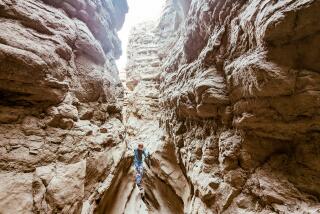Hiking Hacienda to Hacienda
- Share via
QUITO, Ecuador — The women stood in a cobblestone plaza wearing traditional Andean village attire--elaborately embroidered blouses, pleated skirts, rope sandals and woven wool shawls in the brightest reds and magentas.
They had traveled more than an hour on rundown diesel buses to the capital, toting buckets of home-cooked food in hopes of earning a few sucres. Some of the women ladled spoonfuls of stew made from potatoes, corn and beans grown on steep mountain slopes to the north. Others had brought bouquets of roses, sold for the equivalent of 40 cents a dozen.
They had come to Quito from Ecuador’s highlands, a region of remote, snowcapped volcanoes, lush emerald valleys and cool cloud forests--and my destination for a nine-day hiking trip in January.
Almost every other tourist who comes to Quito visits the Galapagos Islands, off the western coast. But it was the highlands--in particular, the centuries-old haciendas there--that captured my interest. Nestled in a double row of mountains (part of the Andes) running north-south, these former farming estates have been converted into gracious country inns with all the amenities of fine hotels--modern bathrooms, fireplaces crackling with fragrant eucalyptus in rooms, beds turned down and electric blankets turned on while travelers relax for dinner. (There’s no central heating.)
I’ve always wanted to visit the Andes. After hearing about a tour offered by Mountain Travel-Sobek of El Cerrito, Calif., I decided to leave my family behind and sign up solo, a present to myself.
I joined nine other travelers--all Americans in their 20s to their 60s--plus two English-speaking Ecuadorean guides. Our itinerary called for hiking four to eight miles most days in elevations of about 9,000 to 12,500 feet. After a night in one of the grand and surprisingly comfortable haciendas, a van would transport us to another area for more hiking.
The Andes is the longest mountain range in the world, running 4,500 miles through South America, from Venezuela in the north to Tierra del Fuego in the south. In Ecuador, peaks nearing 20,000 feet are surrounded by tiny fertile farms that cover the earth in a patchwork of colors.
After hours of flying to Quito and one night at a hotel in the capital, I had traveled by van with my group 45 minutes south to our first hiking destination: the Pasochoa Forest Reserve, named after an extinct volcano with a caldera rising more than 2 1/2 miles into the sky.
It was an easy-to-moderate hike at elevations of 8,000 to 12,000 feet. We strolled through indigenous communities on cobblestone roads toward one of the last undisturbed Andean cloud forests, on the flanks of Pasochoa.
On the road, highlands women often passed us, some leading round-faced children on donkeys, some hunched over with huge bundles of sticks on their backs. These women were captivating, their long, dark hair worn in a single braid; their heads covered in wool hats pulled low, just above dark eyes; their necks wrapped in as many as 30 strands of gold or red beads.
Our walk skirted Pasochoa, whose crater is home to about 100 species of birds. The foliage was thick along the muddy trail, with brilliant flowers and plants growing on top of one another.
The humidity, the wild vegetation and the melodious bird songs created a jungle ambience, but at this elevation the temperature was around 60 degrees, making long pants and jackets a necessity.
After the hike, we drove about 30 miles south to 400-year-old Hosteria La Cienega. Its long, broad carriage road lined with towering eucalyptus trees pulled me in, an invitation to the calm that lay ahead. Through the intricate ironwork door and past the well-manicured courtyard gardens awaited our rooms--double occupancy for most in the group, single for me.
Dinner was a few minutes’ drive away at another hacienda, San Agustin de Callo, a colonial farmhouse whose chapel and dining room have perfectly carved stone walls, remnants of 15th century Incan structures that once stood on this site. In the dining room, lighted only by candelabra, our group shared a delicious Ecuadorean meal of passion fruit and a potato-and-cheese soup, locros de papas.
Hosteria La Cienega and San Agustin de Callo sit in the shadow of the great Cotopaxi, one of the highest active volcanoes in the world (19,347 feet) and the heart of Ecuador’s most-visited national park. Cotopaxi National Park is blessed with clear days--more than anywhere else in the Ecuadorean Andes, according to some guides. The climb to the volcano’s steaming caldera is easy by mountaineering standards, so the summit is popular. Our group remained on its lower flanks, however, at a not-too-shabby 12,500 feet, catching views of its symmetrical snow-covered cone.
It was a weekday, and the park was empty. We were surprised by the solitude, the lack of development. The park has no trails per se and certainly no trail maps, just dirt tracks suitable for four-wheel-drive vehicles. We were grateful for our guides, who knew the land well, spoke excellent English and took good care of the one hiker who fell ill--a one-day bout of upset stomach and altitude sickness.
The guides led us through a moon-like landscape of expansive basins, cinder cones, lava flows and huge boulders planted by the volcano. The last major eruption was in 1877, when avalanches of snow, ice, water and rocks reached the Pacific Ocean. Today, lacy lichens, purple gentians, fire-red Indian paintbrush and blue lupines dot the ground.
For the birding enthusiasts, the guides pointed out the Andean lapwing, which runs on the ground. They also noted the caracara, an Andean raptor with a distinct orange face, and a species of hummingbird that lives at a higher elevation than any other.
From the open basin, we hiked through tall grasses to an ancient Incan ruin. The Incas conquered Ecuadorean Indians in the 1400s, having come from Peru looking for farmland and laborers. Fortresses were strategically located on hilltops, with views of the valleys and mountain passes. We walked around the shallow stone walls and gazed over the desolate terrain, trying to imagine how the Incas defended this vast land.
In 1532, Spaniard Francisco Pizarro arrived to conquer the Incas, marking the beginning of a colonial period that lasted until Ecuador’s independence in 1822.
Midway through our journey, we traveled from the central highlands to the northern highlands, northeast of Quito. We found ourselves at Hacienda Zuleta, a 4,000-acre plantation tucked away in a secluded and tranquil setting about 70 miles north of Quito near Cayambe.
That night, our host, Fernando Polanco, sat at the head of the long dinner table and told us that the hacienda dates to 1691 (it has been in his family since the late 1800s). His grandfather, Galo Plaza Lasso, and great-grandfather, Leonidas Plaza Gutierrez, served as presidents of the country; decades-old photographs show them with Presidents Nixon and Eisenhower in the same living room where we had enjoyed an after-dinner drink.
The next day, Polanco led the group to a deep, narrow valley on his property that ended at a magnificent waterfall over a cliff. We sat with our host as he pointed out flat-topped pyramids, burial grounds of the native Caranqui Indians, who inhabited the region from 9th to 15th centuries.
At the head of the canyon is his trout hatchery, our lunch spot for the day, and the site of his condor project. The endangered Andean condor is one of the largest birds on Earth, with a 10-foot wingspan. The project has eight of the animals; with the help of a zoologist and a biologist, Polanco hopes to breed them and reintroduce them into the wild. We marveled at their white fur collars, naked pink heads and enormous wings, which they fluffed and spread on their perch.
Throughout the trip, lunches were often a combination of traditional American foods and local dishes like potato fritters. We also tried juices made from tamarillos (also called tree tomatoes), passion fruits and other local produce, washed--like the salad greens--with bottled water.
Outside Polanco’s hatchery, we lunched on rainbow trout cooked over a charcoal fire, potatoes smothered in Polanco’s farm-made butter, and wine served in crystal goblets. We sat on hay bales covered with colorful blankets and watched in amazement as two wild condors descended from the sky to visit their captive relatives.
That afternoon we took a break from hiking to ride Polanco’s horses into the mountains for a breathtaking view of the sun setting over Zuleta and the highlands. By night, a full moon lured me down the hacienda’s eucalyptus-lined lane after the others had gone to sleep. I could hear cows chomping and horses breathing as fog blanketed the meadow by my side. With the mountain bases in the distance hidden in low clouds, the peaks floated in the night sky.
Our last days in Ecuador were spent near the wonderful Hosteria Guachala in the Cayambe Valley, a short van ride from Zuleta. This is the home of Nevado Cayambe, a glaciated dormant volcano that is 18,996 feet high.
After a day of scenic hiking, we retired to Guachala, the oldest hacienda in Ecuador, dating to 1580. Once again it was refreshing to forgo modern hotels in favor of an elegant home steeped in history. Besides some impressive restoration, little seemed changed over the centuries.
In the center of the hacienda, in a stone courtyard with a fountain, sheep are sheared and their wool is dyed. That night, in the same courtyard, the hacienda owner arranged for a treat: local folk dancers dressed in traditional costumes and playing reed panpipes and other instruments.
They pulled us down from our seats for the “Dance of the Sun.” We swirled in circles while the music filled the air. Although my own house and loved ones were far away, the hacienda ambience made me feel as if I were home.
(BEGIN TEXT OF INFOBOX / INFOGRAPHIC)
GUIDEBOOK
Trekking in the Ecuadorean Andes
Getting there: From LAX to Quito, Ecuador, connecting flights (change of planes) are on LACSA, American and Continental. Restricted round-trip fares begin at $815 on LACSA, $1,387 on the others.
When to go: Ecuador can be visited year-round, with highs in the 60s and 70s, lows in the high 40s. The dry season in the highlands is June to September; the wettest month is April, when half the days are rainy.
Getting around: My tour was booked through Mountain Travel-Sobek, 6420 Fairmount Ave., El Cerrito, CA 94530; telephone (888) 687-6235, Internet https://www.mtsobek.com. The trip includes seven nights in haciendas and one night in a hotel, plus six days of easy to moderate hiking (other days are spent in transit or visiting a crafts market). Groups range from four to 16 members. The price, which includes lodging and meals but not air fare, is $2,390 per person, double occupancy; the single supplement is $300.
Several other tour operators combine hiking with Ecuadorean haciendas. One of these is Wilderness Travel, 1102 9th St., Berkeley, CA 94710; tel. (800) 368-2794, fax (510) 558-2489, Internet https://www.wildernesstravel.com.
Where to stay: The following were part of my organized tour but can be booked independently.
Hosteria La Cienega, Pan-American Highway South, Kilometer 72; tel./fax 011-593-3-719-093. South of Quito outside Cotopaxi National Park, a 400-year-old hacienda with beautiful grounds. Doubles begin at $40.
Hacienda Zuleta, tel./fax 011-593-2-262-576, Internet https://www.zuleta.com. A 17th century plantation north of Quito, the former home of two Ecuadorean presidents.
Hosteria Guachala, Pan-American Highway North, Kilometer 70 (near Cayambe); tel. 011-593-2-363-042, fax 011-593-2-362-426, Internet https://www.ecuadorexplorer.com/guachala. An elegant hacienda, the oldest in the country. Doubles begin at $35.
For more information: Consulate General of Ecuador, Tourist Information, 8484 Wilshire Blvd., Suite 540, Beverly Hills, CA 90211; tel. (323) 658-6020.
More to Read
Sign up for The Wild
We’ll help you find the best places to hike, bike and run, as well as the perfect silent spots for meditation and yoga.
You may occasionally receive promotional content from the Los Angeles Times.






